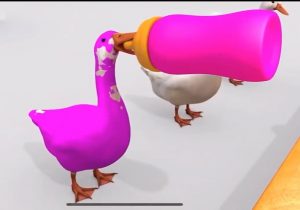Parents should be aware that the early education cognitive animations that children often watch and enjoy might be hidden “toxic animations”.
You never know until you search; it’s shocking when you do.
Next, let’s take a look at the video that ranks first when searching for “color cognition” on a well-known video site.

When I showed this video to people around me, few could detect its toxicity:
Some think there’s nothing unusual, it’s just teaching colors.
Some find it abstract, how can a duck spit out a kitten?
Others wonder why the colors are so bright?
Speaking of this video, children will be very interested and it contains learning objectives, which easily makes parents let their guard down. But it actually has very serious problems. This type of animated video is truly “highly toxic”. Next, let’s talk about where its toxicity lies.
Where is the toxicity of toxic animations
1. Visual impact, making children addicted
These types of videos contain many factors that make children addicted, affecting the secretion of neurotransmitters in the brain.
Firstly, the highest saturation colors that are different from usual vision.
Let’s think about the reaction to high saturation colors in daily life, such as warning signs on the street, life jackets, and big red lanterns hanging high… Aren’t they eye-catching at a glance?
Because such high saturation colors can bring visual impact to the eyes, thereby stimulating the visual center of the brain and capturing our attention.
So when watching the video, children are constantly exposed to high saturation colors, and the brain remains in a state of continuous excitement.
Secondly, these videos have no narrative and frequently switch scenes to attract children’s attention, and then make children addicted by grasping the children’s psychology of liking repetition.
A duck appears in the room, passing by a color fountain, and out comes another animal…
The duck drinks pink drinks to color itself, then the camera cuts to another duck drinking green, then blue…
These visual impacts of color and scenes provide children with continuous excitement.
Similar to short videos, it causes the child’s brain to secrete a large amount of dopamine. This continuous stimulation of the brain is like a kind of mental control, forming a dependence on dopamine, making children unable to control their craving for this feeling, attracting them to addiction.
This has a great impact on the child’s focus.
Studies show that the longer 12-month-old babies are exposed to screens, the stronger the slow-frequency theta waves representing inattentive attention in their brainwaves will be.
This indicates that screen time really can affect children’s attention.
And these data are from studies on children’s attention after watching ordinary videos. It is conceivable that if children continue to watch toxic videos, the impact on their focus will be even greater.
Over time, children will easily become inattentive and even irritable and angry.
In recent days, in order to collect information, I have watched a lot of “toxic videos”, and I can feel a bit irritable. Let alone children.
2. Contradicting science, affecting cognition
These videos instill in children content that contradicts common sense and science, with no logic and narrative, the creatures inside show no emotions, no expressions, and no social interaction scenes.
Regular viewing can have a negative impact on children’s cognition.
Children around 2-3 years old are in the sensitive period for order, and this order is not only about the arrangement of objects but also includes routines and habits in life to establish an understanding of the world.
Children learn to categorize, sort, and logical relationships through understanding and following order in daily life. These cognitive skills can help children advance to more complex logical thinking abilities.
So, if children are long-term exposed to “toxic animation” content, it completely disrupts the sense of order that children should obtain, easily confusing fiction with reality, causing behavioral confusion and logical thinking deviation, leading to cognitive confusion.
3. Good at camouflage, bad guidance
In addition to being disguised as early education cognitive videos, there is another type of “toxic video” that parents are not easily aware of – recreated using familiar animated characters.
For example, bloody and violent Peppa Pig, zombie version of Mickey Mouse, Elsa who is undergoing surgery and pregnancy.
These are all secondary creations based on normal cartoon characters. If you don’t look and listen carefully, you might think they are ordinary animations. However, upon closer inspection, there are many violent scenes inside, such as bleeding, beating, dismemberment, etc., and even containing sexual hints.
You should know that, children under six are in the sensitive period of imitation, and they are prone to imitate the content of animations, showing violent behavior or becoming numb to violence, thus becoming easily emotionally uncontrollable, their values distorted, and their physical and mental health harmed.


Parental Defense Guide
1. Control children’s video watching
Even ordinary videos require controlling the time for young children to watch, referring to the recommendations given by the American Academy of Pediatrics (AAP):
Before 18 months: Try to avoid all screen time except for video calls; 18-24 months: Gradually introduce screen time, no more than half an hour; 2-5 years old: No more than one hour a day, parents should do a good job of screening and accompanying in advance.
2. Screen the videos children watch
Content should be low-stimulus, children’s animations need to slow down:
Choose animations with slow speech, slow rhythm, and pauses. This low-stimulus content is suitable for the development of children’s brains.
Content should be meaningful and reflect children’s daily life and habits:
Choose animations that cover family life scenes, which can reflect and connect with children’s daily lives. Children can learn and draw from the story content to develop good habits and establish the correct psychological order.
These types of animations also come with a lot of high-frequency life vocabulary, promoting children’s language development.
Content should be social, encouraging children to interact and apply it in life:
Interactive animations allow children to interact with the animated characters while watching, waving, dancing, and singing together with the characters. Some even have Q&A sessions where children can answer questions from the animations, full of social attributes.
Content should be attractive to children, entertaining and knowledgeable, and include learning objectives:
You can choose popular science animations, watching while learning common life knowledge, understanding the scientific principles behind everyday things, and stimulating children’s desire to explore and observe.
Watching animations is also a way for children to gain knowledge, such as Super Baby JOJO, Little P優, Blue Koala, etc. In addition, Distinct Health has made a recommendation of high-quality but obscure animations, you can directly copy the homework 👇.
Off-the-beaten-path high-quality animation collection recommendation – Pediatrician’s Roundtable 3. Accompany children while watching videos
“Toxic videos” are very good at camouflage, and once a child opens one, similar content will continue to be pushed, endlessly.
Therefore, it is very necessary for parents to accompany their children in watching videos. Even if we have done the screening work, sometimes after playing normal animations for children, they may also be exposed to toxic animations.
So, accompanying children to watch videos can detect inappropriate video content at the first time.
It is also necessary to check the historical records of various platforms for videos that children have watched before. For platforms with a high content of toxic animations, avoid them.
Of course, there is an ultimate defense move: take children outdoors more, engage in more parent-child games, and parent-child reading activities, away from screen time.
Finally, returning to toxic videos.
Honestly, I am also surprised that there are so many well-disguised toxic videos on the internet around us.
I hope that through this article, more people can understand the true face of toxic videos and keep children away from toxic videos.
References

